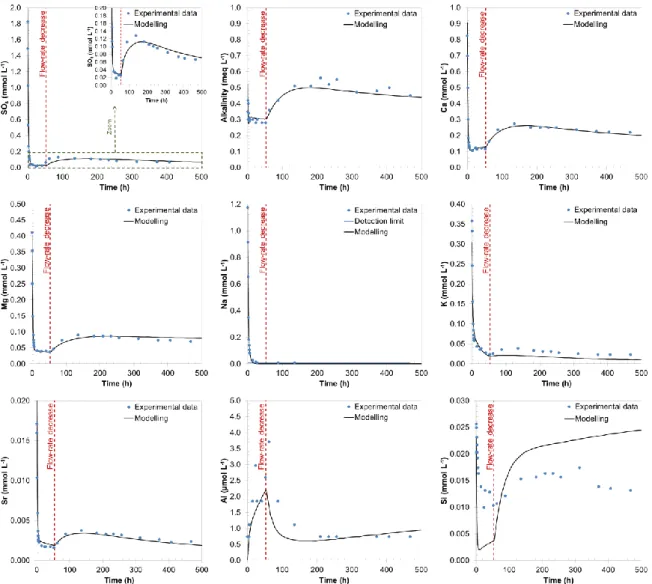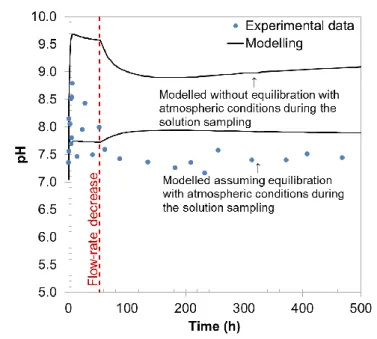HAL Id: hal-01523940
https://hal-brgm.archives-ouvertes.fr/hal-01523940
Submitted on 17 May 2017HAL is a multi-disciplinary open access archive for the deposit and dissemination of sci-entific research documents, whether they are pub-lished or not. The documents may come from teaching and research institutions in France or abroad, or from public or private research centers.
L’archive ouverte pluridisciplinaire HAL, est destinée au dépôt et à la diffusion de documents scientifiques de niveau recherche, publiés ou non, émanant des établissements d’enseignement et de recherche français ou étrangers, des laboratoires publics ou privés.
Oxidation kinetics of tailings from the
Callovo-Oxfordian argillites: flow-through experiments
and modelling at the reactor scale
Nicolas Marty, Adeline Lach, Francis Claret, Christophe Tournassat, Benoît
Madé, Jean-Charles Robinet, Joachim Tremosa
To cite this version:
Nicolas Marty, Adeline Lach, Francis Claret, Christophe Tournassat, Benoît Madé, et al.. Oxidation kinetics of tailings from the Callovo-Oxfordian argillites: flow-through experiments and modelling at the reactor scale. Clay Conference 2017, Sep 2017, Davos, Switzerland. �hal-01523940�
Oxidation kinetics of tailings from the Callovo-Oxfordian
argillites: flow-through experiments and modelling at the reactor
scale.
Nicolas C.M. Marty
1,*, Adeline Lach
1, Francis Claret
1, Christophe Tournassat
3, Benoît
Madé
2, Jean-Charles Robinet
2, Joachim Tremosa
11. BRGM – 3 av. Claude Guillemin BP6009 45060 Orléans cedex 2, France (n.marty@brgm.fr) 2. Andra – Parc de la Croix Blanche, 1-7 rue Jean Monnet, 92298 Châtenay-Malabry Cedex, France 3. Université d’Orléans – CNRS/INSU – BRGM, UMR 7327 Institut des Sciences de la Terre d’Orléans,
45071 Orléans, France * Corresponding author
The building of high level waste repository in deep clay formation will lead to large volumes of excavated rocks that will have to be disposed at the surface, where rock samples will be subject to weathering. The impact of these excavated rocks on the surrounding environment must be studied, in particular the eventuality of acid drainage occurrence because of the presence of pyrite in clay rocks. In addition, tailings are envisaged as sealing/backfill material of galleries. The quantitative evaluation of clay rocks transformations during weathering in the presence of atmosphere conditions is thus necessary to study the feasibility of this technical option. Large volumes of excavated Callovo-Oxfordian argillites (COx) have been produced during the construction of the Andra’s underground laboratory at Bure, and have been stored on site, at the surface. These weathered samples can thus be studied for the objectives stated above. This study aimed to quantify the chemical effect of rainwater on weathered COx samples in order to obtain a set of kinetic data that are representative of COx clay rock reactivity in the presence of water equilibrated with O2 and CO2 at atmospheric partial pressures. Studied material was sampling on the first twenty centimeters of the upper part of 3 years old COx tailings. Flow-through experiments were carried out where outlet-solution chemistry was monitored over time (Fig. 1). Clay suspensions were submitted to aqueous oxidation at various liquid/solid mass ratios (ranging from 8 to 24). Reacting materials was examined prior and after experiments in order to follow mineralogical transformations (XRD, SEM, magnetic measurements). A reactive transport model was then applied to reproduce the data, using PHREEQC3 (Parkhurst and Appelo, 2013), the THERMOCHIMIE database (Giffaut et al., 2014) and reaction kinetic rates published by Marty et al. (2015). Only minor adjustment of reactive surface areas was done to fit outlet concentrations.
Following oxidation of the samples, pyrite oxidized and iron oxide-hydroxides mineral precipitated. Reactive transport model captured well the pyrite oxidation kinetics as shown by the good agreement between modeled and measured sulphate concentrations as a function of time (Fig. 1). Pyrite oxidation is responsible for the acidification of water, but flow through experiment data and modeling evinced that this acidification was counterbalanced very efficiently by the reactivity of the carbonate system in our experimental conditions (Fig. 2). Slightly basic pH were obtained due to calcite alteration leaded to the continuously renewing of the reacting solution (i.e. injection of pure water equilibrated under atmospheric condition). The concentrations of other elements in solution as a function of time were also very well reproduced by the model, with the exception of Si, for which only a qualitative agreement could be obtained. These results indicate that the main processes of clay rock reactivity were correctly identified in our experimental conditions. Due to the high carbonates content inside the COx clay-rock (calcite and dolomite ~ 25 % wt.), acid drainage is clearly unlikely. Selected kinetic data would be applicable to the large-scale modelling dealing with the oxidation of COx tailings.
Fig. 1. Evolution of outlet solution composition as function of time (alkalinity as well as SO4, Ca, Mg, Na, K, Sr, Al and Si concentrations).
Fig. 2. Evolution of pH as function of time. Modelling have been performed both with and without a possible equilibration with atmospheric conditions during the sampling procedure.
References
Giffaut, E., Grivé, M., Blanc, P., Vieillard, P., Colàs, E., Gailhanou, H., Gaboreau, S., Marty, N., Madé, B., Duro, L., 2014. Andra thermodynamic database for performance assessment: ThermoChimie. Applied Geochemistry 49, 225-236.
Marty, N.C.M., Claret, F., Lassin, A., Tremosa, J., Blanc, P., Madé, B., Giffaut, E., Cochepin, B., Tournassat, C., 2015b. A database of dissolution and precipitation rates for clay-rocks minerals. Applied Geochemistry 55, 108-118.
Parkhurst, D.L., Appelo, C.A.J., 2013. Description of input and examples for PHREEQC version 3 - A computer program for speciation, batch-reaction, one-dimensional transport, and inverse geochemical calculations. U.S. Geological Survey Techniques and Methods, , book 6, chap. A43, 497 p., available only at http://pubs.usgs.gov/tm/06/a43.

